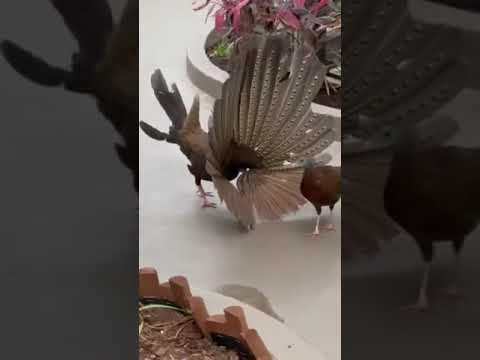– Witnessing nature’s dance: the captivating courtship ritual of the male pheasant.
– A spectacle of colors and moves: how pheasants impress their potential mates.
– Understanding avian romance: the role of dance in pheasant pair bonding and reproduction.
Have you ever stumbled upon a moment in nature so private, so intimate that you couldn’t help but feel like an uninvited guest at a dinner party? You might experience that if you catch the male pheasant during his courtship ritual. But don’t sneak away just yet; you’re about to witness one of nature’s most fascinating performances.
Imagine stepping into the aviary just as the sun begins to cast its golden rays, dappling the enclosure with light spots. Your eyes scan the lush greenery, and there he is – the male pheasant, resplendent in his array of iridescent feathers. The colors are like something from an artist’s palette: deep greens, rich crimsons, and bright blues. He’s impossible to miss, and that’s precisely the point.
The courtship dance of the male pheasant isn’t just a visual treat; it’s a window into the intricate world of avian romance. We’re privileged to see a ritual passed down through countless generations, a dance as old as time and yet as fresh as each new spring. It’s a tale of attraction, competition, and ultimately survival.
Let’s set the scene: our genteel gentleman has spotted a female. She’s foraging nearby, seemingly indifferent to his presence. But he’s not deterred. He begins with a deep breath (or whatever passes for one in the pheasant world). His wings droop slightly as he fans his tail, transforming his silhouette into an eye-catching display. His head bobs, his feet shuffle, and a soft rustling echo through the foliage as he moves.
This isn’t just about showing off his impressive plumage. The dance is a multi-sensory pitch. His movements send vibrations through the ground – think of it as a text message for her senses, indicating his vigor and vitality. The performance can last seconds to several minutes and is not just a one-off audition. The male may repeat this dance dozens of times with all the enthusiasm of a marathon runner on the race’s last leg.
In the meantime, our lady might seem uninterested, busying herself with her affairs. Yet she’s noting everything: the quality of his plumage, the symmetry of his display, the passion in his dance. These elements aren’t just for show – they’re critical indicators of his genetic fitness, ability to evade predators, prowess in finding food, and overall health.
The ritual isn’t only about securing a mate for the season. Pheasants, like many other bird species, are not strictly monogamous. This dance might be a key in securing the loyalty of a female – at least for a short while. It’s an agreement of sorts: she, convinced by his performance, will allow him to sire her next generation; he, in turn, will likely protect the nest or even help to rear the chicks once they hatch.
But our dancer’s journey doesn’t end once he’s won a partner. The world of pheasants is highly competitive, and other males are always waiting in the wings, ready to strut their stuff. Our male’s strength, stamina, and strategy must be ceaselessly honed if he’s to maintain his place in the pecking order.
You might wonder what drives this compulsion to dance; this must be displayed. At its core, it’s the aching pulse of life itself – the imperative to reproduce and ensure that one’s genes carry on into future generations. The male pheasant’s courtship dance is his way of shouting into the void, professing his existence, worth, and desire to be part of the continuing saga of life.
So next time you find yourself at the edge of nature’s dance floor, stand still and admire the show. Think of the energy, the drive, and the years of evolutionary pressure that have shaped this moment. Remember that as unique as this dance may seem, it’s one of countless rituals taking place around the globe, in jungles and deserts, oceans and skies.
It’s a reminder that we, too, are part of this intricate tapestry of life. We may not have feathers to fan or dances to perform, but we each play a role in the grand scheme. Our daily actions, choices, and presence can influence the world around us, just as the vibrancy of our gentleman pheasant shapes the lives of his feathery companions.
In our quest for connection, we can learn from our pheasant friend the value of putting our best foot forward, displaying our virtues, and striving for excellence in our endeavors. After all, isn’t life a dance – a complex, wondrous movement in pursuing fulfillment, companionship, and legacy?
As you peel back the layers of this avian ballet, let it inspire you. Consider the dedication, the artistry, and the raw persistence displayed by a creature we might otherwise pass by without a second glance. Let it urge you to appreciate the subtleties of the world around you, to dig deeper into the often-overlooked wonders, and to understand that beauty and complexity dwell in nature’s every corner.
Whether you’re glimpsing it from the sidelines at your local zoo or fortunate enough to encounter it in the wild, the courtship dance of the male pheasant is a vivid reminder of nature’s brilliance. It’s a show that deserves rapt attention and appreciation for all the mysteries it unveils about the lives of creatures that share our world.
So, when the dance concludes, and the feathers settle, take away more than just the memory of a fleeting spectacle. Carry with you the knowledge that the pheasant’s dance, much like our own journeys, is rooted in something much greater than what meets the eye – the eternal and unyielding force of life, ever-striving, ever-evolving, and always enchanting.
*****
Source Description


